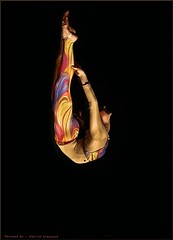My 2011 Goal: Finding My Sweet Spot
I set out this past year on a Mission 2011 to see if I could find my "sweet spot." I defined the sweet spot as a state of energy use would leave me with a little bit of energy remaining at the end of each day. That extra leftover energy would get banked and create an energy reserve.
The concept behind this goal was simple: banked energy would be used by my body to heal. Healing would allow me to expand my energy envelope, the boundary within which I operate on a daily basis: the fine line between functioning and flaring up.
So in theory, finding the sweet spot meant finding the method by which I could get "better," with "better" being defined as the ability to do more while still successfully managing the symptoms of my fibromyalgia and chronic pain disorders.
Where I Started
At the beginning of the year, I thought that examining different aspects of my chronic illness self-management might reveal areas that needed improvement. From there, I figured if I fine-tuned my coping strategies I would be closer to finding and living in my sweet spot.
So I began by reviewing topics like planning, social support, routine, meditation, exercise, mindset, special events, using forms to track symptoms and body mechanics...
The Road I Traveled
Then I hit a really rough patch: a series of stressful events beginning in March. By May I was getting buried and thrown off track with my Mission 2011 review process. I also started making plans to schedule several medical procedures (which I wrote about in my post Mission 2011: Happiness is Having a Plan.) Along the way, I came to realize that having carpal tunnel surgery on both hands and preparing for Hepatitis C treatment were not compatible with my year-long goal.
For all practical purposes, I put my Mission 2011 on hold while I focused my efforts on using all my coping strategies to maintain my status quo and avert flare-ups during the second half of 2011. Switching gears into defensive mode, I learned that I do have the ability to keep my symptoms under pretty good control in the face of difficult circumstances. Despite all the stress, I avoided a major flare-up in 2011 by pacing, planning, resting, asking for help, delegating, saying no and making sure I had fun too.
Unfortunately, there were many days when successful coping meant using all the energy at my disposal to maintain homeostasis. This is not a strategy compatible with banking energy and discovering my sweet spot!
Lessons Learned
So I learned to find my sweet spot I need a stretch of time where I get a break from major stressors like surgery, financial problems and the big annoyances and irritations in life. You know, a period of relative calm in my life.
Despite the mid-year change in course, I am proud of myself for setting this goal and actively pursue it. For the topics I did review, I discovered that I was consistently implementing many of the self-help strategies I learned. I am also proud to say that I wrote 26 blog posts in support of this goal. Along the way, these are the things that I learned about setting a year-long goal:
- The only way to learn and grow is to challenge yourself.
- You won't know if you can accomplish a goal if you don't get started working towards it.
- Every attempt to better yourself moves you closer to a new-and-improved you.
- Even if you don't accomplish your goal, you will gain invaluable knowledge and insights along the way.
- Reviewing your progress (or lack thereof) helps uncover feedback that you can use to be more successful next time.
Fortunately, I can see the light at the end of the tunnel here in 2012. I'd love to say that everything got resolved, but most things did and the rest is tying up a lot of loose ends during this year. The really good news is everything worked out in the end, and that's really all I can ask the Universe to do for me.
As for connecting my goal with my blog, I have to say that I really enjoying the challenge and the built-in accountability. Having a meaty weekly blog topic to write about worked for me. I still find myself thinking about posts I want to write in support of Mission 2011, so I plan to continue the review of my self-help strategies into 2012 and beyond.
I also see that by choosing to treat my Hepatitis C in 2012, things are going to continue along the path of upheaval for another whole new year. So fasten your seatbelts because 2012 is going to be a bumpy ride.
In closing, I'd like to share a random sampling of my Mission 2011 posts below courtesy of the Zemanta widget. You can find them all by clicking the Mission 2011 link here or in the right sidebar under My Blog Topics.
You might also enjoy reading:
- Mission 2011: Living Life 15 Minutes at a Time (ohmyachesandpains.info)
- Mission 2011: Happiness is Having a Plan (ohmyachesandpains.info)
- Mission 2011: Friendship Fresh Start (ohmyachesandpains.info)
- Mission 2011: Finding Social Support Through Social Media (ohmyachesandpains.info)
































